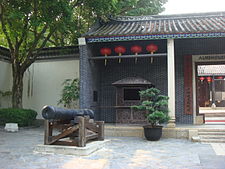In its day, one of the more interesting places on earth was the Kowloon walled city. Just outside of Hong Kong proper, on a disputed part of the Kowloon peninsula, Kowloon walled city was not so much a city as it was a neighborhood. And, it wasn’t so much a neighborhood as it was the closest thing to a nest that human beings have every built or inhabited. Actually, even ‘nest’ is the wrong word, ‘hive’ would be better. Only 0.01 sq mi in area,1 at its peek, the Kowloon Walled City housed an estimated 33,000 people, making it the most densely populated place on earth.

The Walled City was initially just that… a small Chinese fort with walls around it and a local population of maybe a few hundred people. After the Second World War, the city fell into an ambiguous jurisdiction between China and British Hong Kong. Because of the resultant lack of law enforcement, it became a target for thousands of squatters who built building after building within the area where the walls used to stand. By the fifties the Walled City was governed by the Triads who used it as a base of operations for all sorts of criminal activity. In the Seventies the British government negotiated police jurisdiction within the city and successfully drove out the Triads through a series of thousands of raids over the course of a few months. The city continued to grow and develop until the late Eighties when the both the British and Chinese governments decided to demolish the damn place simply because of the squalor and sanitation issues it presented. After about six years of evacuating and transplanting the locals, the Kowloon Walled City was finally demolished in 1993 and replaced with a park which remains there to this day.
The Walled City was, perhaps, one of the most unique places on the planet. It presents a singular place in architecture for example. Hundreds of buildings built wall to wall on just six acres of land made up what amounted to a single complex. The city was so dense that owing to a network patchwork causeways, stairways, planks and ladders, one could travel from one end of the city to the other without ever setting foot on the ground or seeing the sky. Building in the city was entirely ungoverned and full organic with residents making constant makeshift modifications, digging wells, adding plumbing, adding walls, removing walls, building bridges and extensions till the city was less a city and more a massive complex in which tens of thousands of people lived and worked.

Other things about the Walled City are equally fascinating, such as how while the city was largely ungoverned, people living there still managed to lead mostly normal lives. The city had apartments where people lived, shops, small factories, restaurants, butcheries, social centers, community organizations… basically everything you’d expect to see in a normal community you saw in the Walled City, but spontaneous, ungoverned and densely packed and populated. More fascinating than its ungoverned status though was its ungovernable status. For a long while, police weren’t allowed in and the Triads ran the place, but even after that changed, the Walled City was still largely exempt from the laws that governed the rest of Hong Kong. Even ignoring the lack of building code, a proper census was impossible and law enforcement in the tiny roofed alleyways and hallways which were the closest things to streets which the city had was dangerous and impractical. It was too easy for outsiders to get lost while inside and anyone inside would be surrounded on all sides by dozens of people at any one moment. The denseness itself led to an amazing situation where priests wold give sermons, children would play, drug addicts would do drugs and dozens of other people would go about their business all within an area of a few square meters.2

Of course, after the Walled City was destroyed, it was replaced with a park. There really was a full investigation of the society within the city and its gone now and with it an opportunity for an impressive cultural study. The city developed a mystic and separateness from the rest of Hong Kong. It had a lurid reputation which led to its demolition, but it will probably live forever by reputation.
